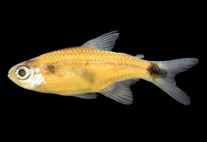Abstract
Species of the genus Serrapinnus from the rio Tocantins-Araguaia basin are revised and three new species are described. Serrapinnus aster new species is diagnosed by the presence of scimitar-shaped ventral procurrent caudal-fin rays of mature males forming a semicircle and by the presence of 7–9 cusps on the premaxillary teeth; S. lucindai new species is distinguished from its congeners by the presence of a higher number of ventral procurrent caudal-fin rays (17 to 19); and S. tocantinensis new species differs from the remaining species of the genus by the elongation of the unbranched dorsal and pelvic-fin rays into filaments in mature males. Serrapinnus sterbai is recognized as broadly distributed in the Tocantins-Araguaia basin and is redescribed based on specimens from across its entire distribution. A key for the cheirodontines occurring in the Atlantic drainages of northeastern Brazil, from the rio Tocantins-Araguaia to the rio Paraguaçú is provided.

